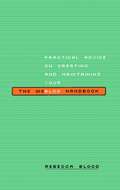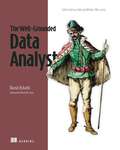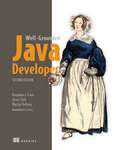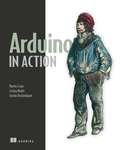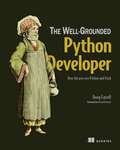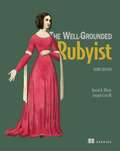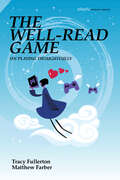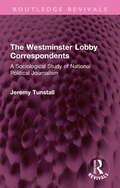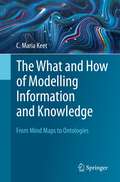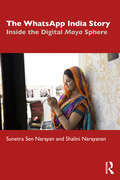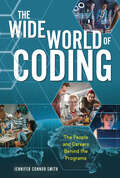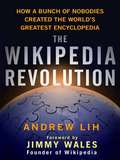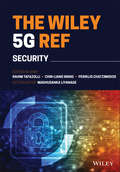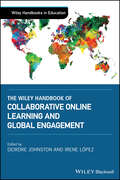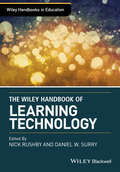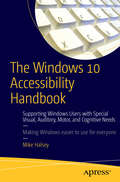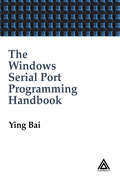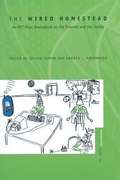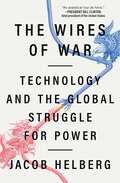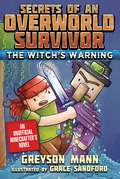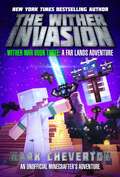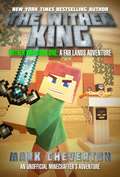- Table View
- List View
The Weblog Handbook: Practical Advice on Creating and Maintaining Your Blog
by Rebecca BloodFinally a book for anyone who has ever thought about starting a Weblog but wasn't sure how to post, where to find links, or even where to go to register. The Weblog Handbook is a clear and concise guide to everything one needs to know about the phenomenon that is exploding on the Web. Rebecca Blood expertly guides the reader through the whole process of starting and maintaining a Weblog and answers any questions that might pop up along the way, such as the elements of good Weblog design and how to find free hosting.
The Well-Grounded Data Analyst: Solve messy data problems like a pro (The Well-Grounded)
by David AsbothComplete eight data science projects that lock in important real-world skills—along with a practical process you can use to learn any new technique quickly and efficiently.Data analysts need to be problem solvers—and The Well-Grounded Data Analyst will teach you how to solve the most common problems you'll face in industry. You'll explore eight scenarios that your class or bootcamp won&’t have covered, so you can accomplish what your boss is asking for. In The Well-Grounded Data Analyst you'll learn: • High-value skills to tackle specific analytical problems • Deconstructing problems for faster, practical solutions • Data modeling, PDF data extraction, and categorical data manipulation • Handling vague metrics, deciphering inherited projects, and defining customer records The Well-Grounded Data Analyst is for junior and early-career data analysts looking to supplement their foundational data skills with real-world problem solving. As you explore each project, you'll also master a proven process for quickly learning new skills developed by author and Half Stack Data Science podcast host David Asboth. You'll learn how to determine a minimum viable answer for your stakeholders, identify and obtain the data you need to deliver, and reliably present and iterate on your findings. The book can be read cover-to-cover or opened to the chapter most relevant to your current challenges. Foreword by Reuven M. Lerner. About the technology Real world data analysis is messy. Success requires tackling challenges like unreliable data sources, ambiguous requests, and incompatible formats—often with limited guidance. This book goes beyond the clean, structured examples you see in classrooms and bootcamps, offering a step-by-step framework you can use to confidently solve any data analysis problem like a pro. About the book The Well-Grounded Data Analyst introduces you to eight scenarios that every data analyst is bound to face. You&’ll practice author David Asboth&’s results-oriented approach as you model data by identifying customer records, navigate poorly-defined metrics, extract data from PDFs, and much more! It also teaches you how to take over incomplete projects and create rapid prototypes with real data. Along the way, you&’ll build an impressive portfolio of projects you can showcase at your next interview. What's inside • Deconstructing problems • Handling vague metrics • Data modeling • Categorical data manipulation About the reader For early-career data scientists. About the author David Asboth is a data generalist educator, and software architect. He co-hosts the Half Stack Data Science podcast. Table of Contents 1 Bridging the gap between data science training and the real world 2 Encoding geographies 3 Data modeling 4 Metrics 5 Unusual data sources 6 Categorical data 7 Categorical data: Advanced methods 8 Time series data: Data preparation 9 Time series data: Analysis 10 Rapid prototyping: Data analysis 11 Rapid prototyping: Creating the proof of concept 12 Iterating on someone else&’s work: Data preparation 13 Iterating on someone else&’s work: Customer segmentation A Python installation instructions
The Well-Grounded Java Developer, Second Edition
by Jason Clark Benjamin Evans Martijn VerburgUnderstanding Java from the JVM up gives you a solid foundation to grow your expertise and take on advanced techniques for performance, concurrency, containerization, and more.In The Well-Grounded Java Developer, Second Edition you will learn: The new Java module system and why you should use it Bytecode for the JVM, including operations and classloading Performance tuning the JVM Working with Java&’s built-in concurrency and expanded options Programming in Kotlin and Clojure on the JVM Maximizing the benefits from your build/CI tooling with Maven and Gradle Running the JVM in containers Planning for future JVM releases The Well-Grounded Java Developer, Second Edition introduces both the modern innovations and timeless fundamentals you need to know to become a Java master. Authors Ben Evans, Martijn Verburg, and Jason Clark distill their decades of experience as Java Champions, veteran developers, and key contributors to the Java ecosystem into this clear and practical guide. You&’ll discover how Java works under the hood and learn design secrets from Java&’s long history. Each concept is illustrated with hands-on examples, including a fully modularized application/library and creating your own multithreaded application. Foreword by Heinz Kabutz. About the technology Java is the beating heart of enterprise software engineering. Developers who really know Java can expect easy job hunting and interesting work. Written by experts with years of boots-on-the-ground experience, this book upgrades your Java skills. It dives into powerful features like modules and concurrency models and even reveals some of Java&’s deep secrets. About the book With The Well-Grounded Java Developer, Second Edition you will go beyond feature descriptions and learn how Java operates at the bytecode level. Master high-value techniques for concurrency and performance optimization, along with must-know practices for build, test, and deployment. You&’ll even look at alternate JVM languages like Kotlin and Clojure. Digest this book and stand out from the pack. What's inside The new Java module system Performance tuning the JVM Maximizing CI/CD with Maven and Gradle Running the JVM in containers Planning for future JVM releases About the reader For intermediate Java developers. About the author Benjamin J. Evans is a senior principal engineer at Red Hat. Martijn Verburg is the principal SWE manager for Microsoft&’s Java Engineering Group. Both Benjamin and Martijn are Java Champions. Jason Clark is a principal engineer and architect at New Relic. Table of Contents PART 1 - FROM 8 TO 11 AND BEYOND! 1 Introducing modern Java 2 Java modules 3 Java 17 PART 2 - UNDER THE HOOD 4 Class files and bytecode 5 Java concurrency fundamentals 6 JDK concurrency libraries 7 Understanding Java performance PART 3 - NON-JAVA LANGUAGES ON THE JVM 8 Alternative JVM languages 9 Kotlin 10 Clojure: A different view of programming PART 4 - BUILD AND DEPLOYMENT 11 Building with Gradle and Maven 12 Running Java in containers 13 Testing fundamentals 14 Testing beyond JUnit PART 5 - JAVA FRONTIERS 15 Advanced functional programming 16 Advanced concurrent programming 17 Modern internals 18 Future Java
The Well-Grounded Java Developer: Vital techniques of Java 7 and polyglot programming
by Benjamin Evans Martijn VerburgSummaryThe Well-Grounded Java Developer offers a fresh and practical look at new Java 7 features, new JVM languages, and the array of supporting technologies you need for the next generation of Java-based software.About the BookThe Well-Grounded Java Developer starts with thorough coverage of Java 7 features like try-with-resources and NIO.2. You'll then explore a cross-section of emerging JVM-based languages, including Groovy, Scala, and Clojure. You will find clear examples that are practical and that help you dig into dozens of valuable development techniques showcasing modern approaches to the dev process, concurrency, performance, and much more.Written for readers familiar with Java. No experience with Java 7 or new JVM languages required. Purchase of the print book comes with an offer of a free PDF, ePub, and Kindle eBook from Manning. Also available is all code from the book. What's InsideNew Java 7 featuresTutorials on Groovy, Scala, and ClojureDiscovering multicore processing and concurrencyFunctional programming with new JVM languagesModern approaches to testing, build, and CITable of ContentsPART 1 DEVELOPING WITH JAVA 7Introducing Java 7New I/OPART 2 VITAL TECHNIQUESDependency InjectionModern concurrencyClass files and bytecodeUnderstanding performance tuningPART 3 POLYGLOT PROGRAMMING ON THE JVMAlternative JVM languagesGroovy: Java's dynamic friendScala: powerful and conciseClojure: safer programmingPART 4 CRAFTING THE POLYGLOT PROJECTTest-driven developmentBuild and continuous integrationRapid web developmentStaying well-grounded
The Well-Grounded Python Developer: How the pros use Python and Flask
by Doug FarrellIf you&’re new to Python, it can be tough to understand when, where, and how to use all its language features. This friendly guide shows you how the Python ecosystem fits together, and grounds you in the skills you need to continue your journey to being a software developer.Summary Inside The Well-Grounded Python Developer you will discover: Building modules of functionality Creating a well-constructed web server application Integrating database access into your Python applications Refactor and decoupling systems to help scale them How to think about the big picture of your application The Well-Grounded Python Developer builds on Python skills you&’ve learned in isolation and shows you how to unify them into a meaningful whole. It helps you understand the dizzying array of libraries and teaches important concepts, like modular construction, APIs, and the design of a basic web server. As you work through this practical guide, you&’ll discover how all the bits of Python link up as you build and modify a typical web server application—the kind of web app that&’s in high demand by modern businesses. About the technology As a new programmer, you&’re happy just to see your code run. A professional developer, on the other hand, needs to create software that runs reliably. It must be fast, maintainable, scalable, secure, well designed and documented, easy for others to update, and quick to ship. This book teaches you the skills you need to go from Python programmer to Python developer. About the book The Well-Grounded Python Developer shows you why Python, the world&’s most popular programming language, is a fantastic tool for professional development. It guides you through the most important skills, like how to name variables, functions, and classes, how to identify and write a good API, and how to use objects. You&’ll also learn how to deal with inevitable failures, how to make software that connects to the internet, core security practices, and many other professional-grade techniques. What's inside Create a web application Connect to a database Design programs to handle big tasks About the reader For experienced beginners who want to learn professional-level skills. About the author Doug Farrell has been a professional developer since 1983, and has worked with Python for over 20 years. Table of Contents 1 Becoming a Pythonista PART 1 - GROUNDWORK 2 That&’s a good name 3 The API: Let&’s talk 4 The object of conversation 5 Exceptional events PART 2 - FIELDWORK 6 Sharing with the internet 7 Doing it with style 8 Do I know you? Authentication 9 What can you do? Authorization 10 Persistence is good: Databases 11 I&’ve got something to say 12 Are we there yet?
The Well-Grounded Rubyist
by Joe LeoSummaryThe Well-Grounded Rubyist, Third Edition is a beautifully written tutorial that begins with your first Ruby program and takes you all the way to sophisticated topics like reflection, threading, and recursion. Ruby masters David A. Black and Joe Leo distill their years of knowledge for you, concentrating on the language and its uses so you can use Ruby in any way you choose. Updated for Ruby 2.5.Purchase of the print book includes a free eBook in PDF, Kindle, and ePub formats from Manning Publications.About the TechnologyDesigned for developer productivity, Ruby is an easy-to-learn dynamic language perfect for creating virtually any kind of software. Its famously friendly development community, countless libraries, and amazing tools, like the Rails framework, have established it as the language of choice for high-profile companies, including GitHub, SlideShare, and Shopify. The future is bright for the well-grounded Rubyist!About the BookIn The Well-Grounded Rubyist, Third Edition, expert authors David A. Black and Joseph Leo deliver Ruby mastery in an easy-to-read, casual style. You'll lock in core principles as you write your first Ruby programs. Then, you'll progressively build up to topics like reflection, threading, and recursion, cementing your knowledge with high-value exercises to practice your skills along the way.What's InsideBasic Ruby syntaxRunning Ruby extensionsFP concepts like currying, side-effect-free code, and recursionRuby 2.5 updatesAbout the ReaderFor readers with beginner-level programming skills.About the AuthorsDavid A. Black is an internationally known Ruby developer and author, and a cofounder of Ruby Central. Ruby teacher and advocate Joseph Leo III is the founder of Def Method and lead organizer of the Gotham Ruby Conference. Table of ContentsPART 1 RUBY FOUNDATIONSBootstrapping your Ruby literacyObjects, methods, and local variablesOrganizing objects with classesModules and program organizationThe default object (self), scope, and visibilityControl-flow techniquesPART 2 BUILT-IN CLASSES AND MODULESBuilt-in essentialsStrings, symbols, and other scalar objectsCollection and container objectsCollections central: Enumerable and EnumeratorRegular expressions and regexp-based string operationsFile and I/O operationsPART 3 RUBY DYNAMICSObject individuationCallable and runnable objectsCallbacks, hooks, and runtime introspectionRuby and functional programming
The Well-Read Game: On Playing Thoughtfully (Playful Thinking)
by Tracy Fullerton Matthew FarberHow players evoke personal and subjective meanings through a new theory of player response.In The Well-Read Game, Tracy Fullerton and Matthew Farber explore the experiences we have when we play games: not the outcomes of play or the aesthetics of formal game structures but the ephemeral and emotional experiences of being in play. These are the private stories we tell ourselves as we play, the questions we ask, and our reactions to the game&’s intent. These experiences are called &“readings&” because they involve so many of the aspects of engaging with literary, cinematic, and other expressive texts. A game that is experienced in such a way can be called &“well-read,&” rather than, or as well as, &“well-played,&” because of the personal, interpretive nature of that experience and the way in which it relates to our reading of texts of all kinds.The concept of the &“well-read game&” exists at the convergence of literary, media, and play theories—specifically, the works of Louise Rosenblatt&’s reader-response theory, Brian Upton&’s situational game theory, Tracy Fullerton&’s playcentric design theory, and Bernie DeKoven&’s well-played game philosophy. Each of these theories, from their own perspective, challenges notions of a separate, objective, or authorial meaning in a text and underscores the richness that arises from the varied responses of readers, who coauthor the meaning of each text through their active engagement with it. When taken together, these theories point to a richer understanding of what a game is and how we might better value our experiences with games to become more thoughtful readers of their essential meanings.
The Westminster Lobby Correspondents: A Sociological Study of National Political Journalism (Routledge Revivals)
by Jeremy TunstallThe Westminster Lobby correspondents have a special place in both the politics and the mass media of Britain. These journalists dominate the behind-the-scenes reporting of British national politics. In this book, originally published in 1970, Jeremy Tunstall presents the first systematic social science study of the uniquely British phenomenon of Lobby correspondents.The study includes data collected from interviews with the national Lobby correspondents, who also completed lengthy questionnaires. It contains evidence of their careers, political opinions, pay, working conditions, relationships with their employing news organization and political news sources, and on the way in which the correspondents both compete with, and exchange information with, each other. As well as this fascinating empirical data, the book offers an important contribution to the sociology of politics and the mass media, and to the study of ‘organizational intelligence’ and the sociology of occupations.There had long centred upon the Lobby correspondents many myths and misconceptions, which Jeremy Tunstall effectively demolishes. (The so-called ‘Lobby rules’ were here published for the first time.) Other real dilemmas are, however, revealed: the competing demands of publicity and secrecy; the dilemmas of British politics in which basic principles – such as Parliamentary supremacy and Cabinet secrecy – are daily breached, not only by the correspondents, but also by leading politicians; and the problems of a system of political communication whose obsession with daily news values is so similar to official and academic contributions. With media and politics still very much linked today, this reissue can be read and enjoyed in its historical context.
The What and How of Modelling Information and Knowledge: From Mind Maps to Ontologies
by C. Maria KeetThe main aim of this book is to introduce a group of models and modelling of information and knowledge comprehensibly. Such models and the processes for how to create them help to improve the skills to analyse and structure thoughts and ideas, to become more precise, to gain a deeper understanding of the matter being modelled, and to assist with specific tasks where modelling helps, such as reading comprehension and summarisation of text. The book draws ideas and transferrable approaches from the plethora of types of models and the methods, techniques, tools, procedures, and methodologies to create them in computer science. This book covers five principal declarative modelling approaches to model information and knowledge for different, yet related, purposes. It starts with entry-level mind mapping, to proceed to biological models and diagrams, onward to conceptual data models in software development, and from there to ontologies in artificial intelligence and all the way to ontology in philosophy. Each successive chapter about a type of model solves limitations of the preceding one and turns up the analytical skills a notch. These what-and-how for each type of model is followed by an integrative chapter that ties them together, comparing their strengths and key characteristics, ethics in modelling, and how to design a modelling language. In so doing, we’ll address key questions such as: what type of models are there? How do you build one? What can you do with a model? Which type of model is best for what purpose? Why do all that modelling? The intended audience for this book is professionals, students, and academics in disciplines where systematic information modelling and knowledge representation is much less common than in computing, such as in commerce, biology, law, and humanities. And if a computer science student or a software developer needs a quick refresher on conceptual data models or a short solid overview of ontologies, then this book will serve them well.
The WhatsApp India Story: Inside the Digital Maya Sphere
by Sunetra Sen Narayan Shalini NarayananWhatsApp is used by over half a billion people in India today in all fields – in business, corporate and informal sectors, in government, for education and among friends, families and acquaintances. This book critically explores the social messaging app’s rapid expansion in India and its growing influence and looks at whether, as a form of horizontal communication, it poses a challenge to more traditional structures of communication. The book examines WhatsApp’s spread in the personal and professional lives of Indians and the myriad ways in which people in India are using the app in social and business interactions, including among people living with disabilities. Using case studies, interviews, surveys and in-depth research, it analyses key aspects of WhatsApp’s massive popularity and its impact on how people communicate. It also explores its impact on the psycho-social dynamics in India, including the dissemination of fake news and politically motivated content, and the consequent need for media regulation in the country. One of the first books to analyse the pervasiveness of WhatsApp and social media apps in different areas of Indian society, this book will be of interest to scholars and students of media studies, communication studies, digital media, cultural studies, cyberculture studies, sociology and social policy and media law.
The Wide World of Coding: The People and Careers behind the Programs
by Jennifer Connor-SmithThe best part about coding is that anyone with a computer can learn how to do it. From education to healthcare to entertainment, software touches almost every aspect of twenty-first century life. Take a high-level perspective on the types of people who create that software—including many jobs that do not involve writing code at all. Learn about the software development cycle and the huge variety of skills developers draw on, including psychology, mathematics, and art, to create amazing apps and programs. Explore why diversity is needed to prevent bias in design. Learn about the different coding languages and what they are used for, how developers choose a language, and tools that simplify coding. Jennifer Connor-Smith breaks down stereotypes about coding as a career that is open only to technology-obsessed gamers, revealing ways people use software to improve medical care, nurture dementia patients, promote social justice, and more. Hands-on activities show you how easy it is to learn to think like a coder. The next generation of coders will require diverse teams, creativity, and ethical codes of conduct to create the best and most successful software. Will you be one of them?
The Wikipedia Revolution: How a Bunch of Nobodies Created the World's Greatest Encyclopedia
by Andrew Lih"Imagine a world in which every single person on the planet is given free access to the sum of all human knowledge. That's what we're doing." --Jimmy WalesWith more than 2,000,000 individual articles on everything from Aa! (a Japanese pop group) to Zzyzx, California, written by an army of volunteer contributors, Wikipedia is the #8 site on the World Wide Web. Created (and corrected) by anyone with access to a computer, this impressive assemblage of knowledge is growing at an astonishing rate of more than 30,000,000 words a month. Now for the first time, a Wikipedia insider tells the story of how it all happened--from the first glimmer of an idea to the global phenomenon it's become.Andrew Lih has been an administrator (a trusted user who is granted access to technical features) at Wikipedia for more than four years, as well as a regular host of the weekly Wikipedia podcast. In The Wikipedia Revolution, he details the site's inception in 2001, its evolution, and its remarkable growth, while also explaining its larger cultural repercussions. Wikipedia is not just a website; it's a global community of contributors who have banded together out of a shared passion for making knowledge free.Featuring a Foreword by Wikipedia founder Jimmy Wales and an Afterword that is itself a Wikipedia creation.
The Wild Side of Photography
by Cyrill HarnischmacherGeared toward the adventurous photographer, The Wild Side of Photography provides a rich source of ideas and inspiration for fun projects ranging from clever to unconventional. Learn to build a shift/tilt lens for your DSLR from an old junkyard 120 film camera, try the camera toss, shoot images from a kite, use a peephole door viewer as a fisheye lens, or build your own pinhole camera. Get ready to capture the perfect aerial shot on your next commercial flight, and to paint beautiful night scenes using a flashlight as a lightbrush. Author/designer, Cyrill Harnischmacher, brought together 20 international authors and their unique projects to produce this intriguing book. Each project is presented with easy to understand instructional text, background info about the author and the project, and beautiful color images to illustrate what can be accomplished and how you can do it too. Topics include: - Laptop ministudio - Camera hacks - Pole monopods for aerial photography - Blur (motion blur, camera motion, out-of-focus) - Low budget astrophotography - Kite photography - Using the scanner as a camera - LittlePlanet views - Texture blending - Camera and lens building projects
The Wiley 5G REF: Security
by Madhusanka Liyanage Periklis Chatzimisios Rahim Tafazolli Chin-Liang WangFrom the Section Editor’s Foreword by Dr. Madhusanka Liyanage, University College Dublin, Ireland. The Wiley 5G Ref: Security offers a stellar collection of articles selected from the online-only Work, The Wiley 5G Reference. It aims to provide a solid educational foundation for researchers and practitioners in the field of 5G Security and Privacy to expand their knowledge base by including the latest developments in these disciplines. The book introduces the security landscape of 5G, and significant security and privacy risks associated with the 5G networks. Then, the security solutions for different segments of the 5G network, i.e., radio network, edge network, access network, and core network, are discussed. Since 5G is developed based on network softwarization, security threats associated with key network softwarization technologies such as SDN, NFV, NS, and MEC are also presented in detail. Then, the security issues related to the new 5G and IoT services are delivered. Finally, a detailed discussion on the privacy of 5G networks is presented by considering Datafied Society. Written by leading experts in security and privacy for the telecommunication network, this book is intended to provide additional learning opportunities for a wide range of readers, from graduate-level students to seasoned engineering professionals. We are confident that this book and the entire collection of selected articles will continue Wiley’s tradition of excellence in technical publishing and provide a lasting and positive contribution to the teaching and practice of security and privacy of 5G and beyond networks.
The Wiley Handbook of Collaborative Online Learning and Global Engagement (Wiley Handbooks in Education)
by Irene López Deirdre JohnstonPresents best practices for faculty and administrators developing globally-connected courses, including learning objectives, collaborative assignments, and logistical planning As political instability, pandemic risks, rising costs, new requirements for experiential learning, and other factors make it increasingly difficult for students to study abroad, there is growing interest in globalizing and internationalizing the curricula of colleges and universities worldwide. The Wiley Handbook of Collaborative Online Learning and Global Engagement is designed to help educators develop and conduct high-impact, globally-connected courses across the humanities, the fine arts, and the social and natural sciences. This comprehensive guide covers collaborative practices, course design variables, student learning approaches, logistical planning, and more. An international team of contributors from diverse geographic, cultural, and academic backgrounds offer insight into enhancing pedagogical practice, coordinating study abroad experiences, and promoting both students' and faculty's global competencies. Throughout the text, numerous real-world case studies, interactive and experiential assignments, sample syllabi, course bibliographies, and links to web and media resources reinforce best practices for course design, learning objectives, and pedagogy development. Based on a detailed assessment of 500 students in collaborative courses across 14 countries, this innovative guide: Covers co-development of learning objectives across different courses, disciplines and cultural contexts, co-coordination of course content, technology, and resources, and intercultural learning assessment Explores new and innovative ways to engage students in distant locations in collaborative learning Provides advice for overcoming logistical challenges, managing group dynamics, controlling costs, and implementing connected courses with limited resources Discusses the impact globally-connected courses have on cultural curiosity, knowledge, strategy, and behavior Offers approaches for addressing cultural transgressions and miscommunication, and for collaborating with other faculty members across cultures and educational systems Featuring multiple cultural perspectives and international contexts, The Wiley Handbook of Collaborative Online Learning and Global Engagement is a valuable guide and reference for faculty and administrators involved in teaching, planning, implementing, or assessing courses with global learning outcomes.
The Wiley Handbook of Learning Technology (Wiley Handbooks in Education)
by Nick Rushby Daniel W. SurryThe Wiley Handbook of Learning Technology is an authoritative and up-to-date survey of the fast-growing field of learning technology, from its foundational theories and practices to its challenges, trends, and future developments. Offers an examination of learning technology that is equal parts theoretical and practical, covering both the technology of learning and the use of technology in learning Individual chapters tackle timely and controversial subjects, such as gaming and simulation, security, lifelong learning, distance education, learning across educational settings, and the research agenda Designed to serve as a point of entry for learning technology novices, a comprehensive reference for scholars and researchers, and a practical guide for education and training practitioners Includes 29 original and comprehensively referenced essays written by leading experts in instructional and educational technology from around the world
The Windows 10 Accessibility Handbook
by Mike HalseyLearn everything you need to know about making Windows 10 easier to use, see, hear, touch, or read, whether you are using it yourself, setting it up for another person, teaching others about ease of use at work or in the home, or working with a variety of people with specific needs in the community. What you'll learn Manage accessibility in the Settings app, and make use of the Ease of Access Center Make your keyboard and mouse easier to use Make text and windows easier to read Use text or visual alternatives for sounds Use the narrator, and control it using touch and with the keyboard Use Cortana as a smart PC assistant Make use of Windows 10 shortcut keys, and touch and trackpad gestures Use and train the handwriting recognition feature Dictate or navigate using speech recognition Who this book is for The audience for this book includes (but is not limited to) Windows users with special visual, auditory, motor, and cognitive needs, at home and in the workplace. It provides guidance for IT and management professionals who work with such users, as well as the community and statutory groups, organizations, colleges, universities, and government agencies that support them. It is also a guide for friends and family supporting elderly or disabled Windows users in the home, and for anyone else looking for advice on how to make their PC simpler, easier, more productive, and ultimately more enjoyable to use. Table of Contents Chapter 1: Introducing Accessibility in Windows 10 Chapter 2: Identifying Your Needs Chapter 3: Using Windows 10 with a Visual Impairment Chapter 4: Using Windows 10 with a Hearing Impairment Chapter 5: Making the Keyboard and Mouse Easier to Use Chapter 6: Touch and Alternative Input Options Chapter 7: Windows 10 for Memory, Learning, or Other Cognitive Impairments Chapter 8: Managing Accessibility in Windows 10 Mobile Chapter 9: Windows 10 Usability Tips and Tricks
The Windows Screen Reader Primer: All the Basics and More
by David KingsburyFor those with visual impairments, screen reader software is crucial for living in today’s world. Keeping up to date with changes when applications are updated is critical to being an independent computer user. Authored by an Assistive Technology Instructor at the Carroll Center for the Blind in Massachusetts, the book is meant to help JAWS, NVDA, and Windows Narrator users work more effectively with the most important Windows-based applications—the Microsoft Office suite, popular web browsers, cloud sharing apps, Zoom for meetings, and more. The book is intended for both beginners and intermediate users. While all the basics are covered, those already possessing a fair amount of experience using screen reader programs in the Windows environment will find useful tools and techniques to further enhance their skills.
The Windows Screen Reader Primer: All the Basics and More
by David KingsburyThe "Windows Screen Reader Primer: Third Edition" offers comprehensive guidance for users of JAWS, NVDA, and Windows Narrator, focusing on essential Windows applications, Office Suite tools, web browsers, cloud-based platforms, PDF readers, and teleconferencing software. With updates for Windows 11 and recent software versions, it includes new chapters on Google Workspace, audio-video editing, and AI integration. The book caters to beginners and intermediate users, providing step-by-step instructions, customizable settings, and practical exercises. Accessible formats and navigation tips enhance usability, making it an invaluable resource for mastering screen reader usage in the Windows environment.
The Windows Serial Port Programming Handbook
by Ying BaiThe popularity of serial communications demands that additional serial port interfaces be developed to meet the expanding requirements of users. The Windows Serial Port Programming Handbook illustrates the principles and methods of developing various serial port interfaces using multiple languages. This comprehensive, hands-on, and practical guide.
The Wired Homestead: An MIT Press Sourcebook on the Internet and the Family
by Joseph Turow Andrea L. KavanaughThe use of the internet in homes rivals the advent of the telephone, radio, or television in social significance.
The Wires of War: Technology and the Global Struggle for Power
by Jacob HelbergFrom the former news policy lead at Google, an urgent and groundbreaking account of the high-stakes global cyberwar brewing between Western democracies and the autocracies of China and Russia that could potentially crush democracy.From 2016 to 2020, Jacob Helberg led Google&’s global internal product policy efforts to combat disinformation and foreign interference. During this time, he found himself in the midst of what can only be described as a quickly escalating two-front technology cold war between democracy and autocracy. On the front-end, we&’re fighting to control the software—applications, news information, social media platforms, and more—of what we see on the screens of our computers, tablets, and phones, a clash which started out primarily with Russia but now increasingly includes China and Iran. Even more ominously, we&’re also engaged in a hidden back-end battle—largely with China—to control the Internet&’s hardware, which includes devices like cellular phones, satellites, fiber-optic cables, and 5G networks. This tech-fueled war will shape the world&’s balance of power for the coming century as autocracies exploit twenty-first-century methods to re-divide the world into twentieth century-style spheres of influence. Helberg cautions that the spoils of this fight are power over every meaningful aspect of our lives, including our economy, our infrastructure, our national security, and ultimately, our national sovereignty. Without a firm partnership with the government, Silicon Valley is unable to protect democracy from the autocrats looking to sabotage it from Beijing to Moscow and Tehran. The stakes of the ongoing cyberwar are no less than our nation&’s capacity to chart its own future, the freedom of our democratic allies, and even the ability of each of us to control our own fates, Helberg says. And time is quickly running out.
The Witch's Warning (Secrets of an Overworld Survivor #5)
by Grace Sandford Greyson MannWhen lightning hits Little Oak, one of Will and Mina’s villager friends gets struck—and turned into a witch! Mina and Will sprint straight to the witch huts in the swamp, trying to save their friend. But instead of help, they find grave danger: witches with potions so powerful, Mina’s own potions seem weak and useless. When Mina falls victim to a witch’s potion, it’s Will who has to perfect his potion-making skills. Can he remember what Mina taught him in time to save her from the deadly secrets swirling deep within the swamp?
The Wither Invasion (Wither War #3)
by Mark ChevertonIn the concluding third book of a new Minecraft adventure series from New York Times bestselling author Mark Cheverton, Watcher fights the wither king’s army to save Minecraft itself from destruction. With Krael, the king of the withers, trapped in another world, the young wizard Watcher thinks the Great War is finally over. . . . but he’s wrong. Intent on destroying all villagers, Krael has found a way to bring his army to the Far Lands. Now, with Krael’s vicious horde chasing them, Watcher and his friends must save as many villages as possible before making their final stand. But, outnumbered by monsters stronger than they’ve ever seen, it seems hopeless. It will be left to Watcher to save them, and, with a secret weapon of mass destruction, the young wizard will be forced to make a decision: Should he destroy millions of monsters, or should the villagers stand and fight, knowing they’ll die? What Watcher doesn’t know is that a secret built into the ancient weapon could change the course of the war . . . for better or for worse.
The Wither King: Wither War Book One: A Far Lands Adventure: An Unofficial Minecrafter's Adventure (Wither War)
by Mark ChevertonLife is peaceful and calm in the Far Lands, a mysterious area on the edge of the Overworld in Minecraft. The monster warlords have been destroyed, and the NPC villages are flourishing. But an old warning still echoes in the young NPC Watcher’s mind: “Krael, the new Wither King, will bring back his army, as the monster warlocks predicted, and take their revenge on all of the Far Lands.” Watcher is right to be suspicious. Krael, the self-proclaimed King of the Withers, and wearer of the Crown of Skulls, has a plan to bring back the vast army of withers that lie imprisoned in the ancient Cave of Slumber. With the help of a dozen ancient zombie warriors rescued by Krael, they seek to release the withers from their slumber and wreak havoc on the Far Lands. And the only thing in his path is a skinny little archer named Watcher.
